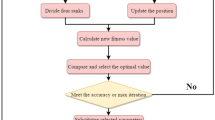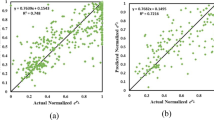Abstract
Liquefaction of loose, saturated granular soils during earthquakes poses a major hazard in many regions of the world. Determining the liquefaction potential of soils induced by earthquakes is a major concern and an essential criterion in the design process of civil engineering structures. The present study examines the potential of support vector machines (SVMs) for assessing liquefaction potential based on cone penetration test (CPT) field data. A hybrid model based on a combination of SVMs and particle swarm optimization (PSO) is proposed in this study to improve the forecasting performance. PSO was employed in selecting the appropriate SVM parameters to enhance forecasting accuracy. Nine parameters, such as earthquake magnitude, the water table, the total vertical stress, the effective vertical stress, the depth, the peak acceleration at the ground surface, the cyclic stress ratio, the mean grain size and the measured CPT tip resistance, were used as input parameters. Prediction results demonstrate that the classification accuracy rates of the developed PSO–SVM approach surpass those of a grid search and many other approaches.










Similar content being viewed by others
References
Banerjee T, Das S (2012) Multi-sensor data fusion using support vector machine for motor fault detection. Inf Sci 217:96–107
Boulanger RW, Mejia LH, Idriss IM (1997) Liquefaction at Moss Landing during Loma Prieta earthquake. J Geotech Geoenviron Eng 123(5):453–467
Chern SG, Lee CY (2009) CPT-based simplified liquefaction assessment by using fuzzy-neural network. J Mar Sci Technol 17(4):326–331
Dibike YB, Velickov S, Solomatine D, Abbott MB (2001) Model induction with support vector machines: introduction and applications. J Comput Civ Eng 15(3):208–216
Farrokhzad F, Choobbasti AJ, Barari A (2012) Liquefaction microzonation of Babol city using artificial neural network. J King Saud Univ Sci 24(1):89–100
Ghosh S, Das S, Kundu D, Suresh K, Panigrahi BK, Cui ZH (2012) An inertia-adaptive particle swarm system with particle mobility factor for improved global optimization. Neural Comput Appl 21(2):237–250
Goh ATC (1995) Seismic liquefaction potential assessed by neural networks. J Geotech Geoenviron Eng 120(9):1467–1480
Huang Y, Jiang XM (2010) Field-observed phenomena of seismic liquefaction and subsidence during the 2008 Wenchuan earthquake in China. Nat Hazards 54:839–850
Huang Y, Yu M (2013) Review of soil liquefaction characteristics during major earthquakes of the twenty-first century. Nat Hazards 65:2375–2384
Huang Y, Zhang WJ, Mao WW, Jin C (2011) Flow analysis of liquefied soils based on smoothed particle hydrodynamics. Nat Hazards 59:1547–1560
Juang CH, Yuan HM, Lee DH, Lin PS (2003) Simplified cone penetration test-based method for evaluating liquefaction resistance of soils. J Geotech Geoenviron Eng 129(11):66–80
Kennedy J, Eberhart RC (1995) Particle swarm optimization. In: Proceedings of the 1995 IEEE international conference on neural networks 4, Perth, Australia. IEEE Service Center, Piscataway, NJ, pp 1942–1948
Law KT, Cao YL, He GN (1990) An energy approach for assessing seismic liquefaction potential. Can Geotech J 27:320–329
Lee CY, Chern SG (2013) Application of a support vector machine for liquefaction assessment. J Mar Sci Technol 21(3):318–324
Lee Y, Lee C (2003) Classification of multiple cancer types by multicategory support vector machines using gene expression data. Bioinformatics 19:1132–1139
Liao SC, Veneziano D, Whitman RV (1988) Regression models for evaluating liquefaction probability. J Geotech Eng 114(4):389–411
Maalouf M, Khoury N, Trafalis TB (2008) Support vector regression to predict asphalt mix performance. Int J Numer Anal Methods Geomech 30:983–996
Mahesh P (2006) Support vector machines-based modelling of seismic liquefaction potential. Int J Numer Anal Methods Geomech 30:983–996
Maria JS (2011) Applying artificial neural networks for analysis of geotechnical problems. Comput Assist Mech Eng Sci 18:231–241
Mert T (2013) A comparative study on computer aided liquefaction analysis methods. Int J for Hous Sci 37(2):121–135
Muduli PK, Das SK (2014a) CPT-based seismic liquefaction potential evaluation using multi-gene genetic programming approach. Indian Geotech J 44(1):86–93
Muduli PK, Das SK (2014b) Evaluation of liquefaction potential of soil based on standard penetration test using multi-gene genetic programming model. Acta Geophys 62(3):529–543
Mughieda O, Bani HK, Safieh B (2009) Liquefaction assessment by artificial neural networks based on CPT. Int J Geotech Eng 2:289–302
Nasir M, Das S, Maity D, Sengupta S, Halder U, Suganthan PN (2012) A dynamic neighborhood learning based particle swarm optimizer for global numerical optimization. Inf Sci 209:16–36
Park D, Rilett LR (1999) Forecasting freeway link ravel times with a multi-layer feed forward neural network. Comput Aided Civ Inf 14:358–367
Ramakrishnan D, Singh TN, Purwar N, Badre KS, Gulati A, Gupta S (2008) Artificial neural network and liquefaction susceptibility assessment: a case study using the 2001 Bhuj earthquake data, Gujarat, India. Comput Geosci 12:491–501
Robertson PK, Wride CE (1998) Evaluating cyclic liquefaction potential using the cone penetration test. Can Geotech J 35(3):442–459
Sami M, de Patrick B (2005) Minimum principle and related numerical scheme for simulating initial flow and subsequent propagation of liquefied ground. Int J Numer Anal Methods Geomech 29:1065–1086
Samui P, Sitharam TG (2011) Machine learning modelling for prediction soil liquefaction susceptibility. Nat Hazards Earth Syst Sci 11:1–9
Seed HB, Idriss IM (1971) Simplified procedure for evaluating soil liquefaction potential. J Soil Mech Found Div ASCE 97(9):1249–1273
Seed HB, Idriss IM, Arrango I (1983) Evaluation of liquefaction potential using field data. J Geotech Eng 109:458–484
Trafalis TB, Ince H (2000) Support vector machine for regression and applications to financial forecasting. IJCNN 6:348–353
Trafalis TB, Ince H, Richman M (2003) Tornado detection with support vector machines. Int Conf Comput Sci Melb Austria 2660:289–298
Vapnik V (1995) The nature of statistical learning theory. Springer, New York
Xu HB, Chen GH (2013) An intelligent fault identification method of rolling bearings based on LSSVM optimized by improved PSO. Mech Syst Signal Process 35:167–175
Xue XH, Yang XG (2013) Application of the adaptive neuro-fuzzy inference system for prediction of soil liquefaction. Nat Hazards 67:901–917
Author information
Authors and Affiliations
Corresponding author
Rights and permissions
About this article
Cite this article
Xue, X., Yang, X. Seismic liquefaction potential assessed by support vector machines approaches. Bull Eng Geol Environ 75, 153–162 (2016). https://doi.org/10.1007/s10064-015-0741-x
Received:
Accepted:
Published:
Issue Date:
DOI: https://doi.org/10.1007/s10064-015-0741-x




